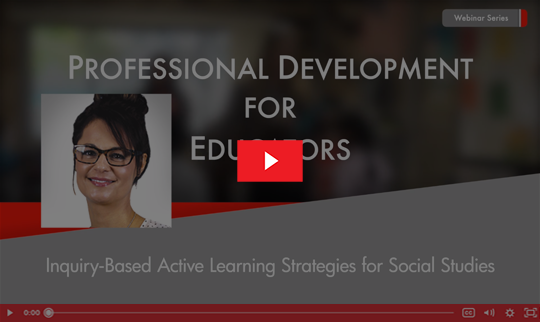Using Inquiry to Achieve Equity: Inquiry-Based Learning for Social Studies
Today, more than ever, social studies teachers have both an opportunity and an obligation to provide our students not with static, one-dimensional content from a textbook, but rather with content that will provide students with the multi-perspective disciplinary knowledge from all those that have contributed to our collective history. When teachers break away from the textbook, they can provide customized content that meets the needs of their students academically, while also enhancing their critical thinking skills about the content. The zenith of this opportunity is when social studies teachers combine student choice with literacy and deliver this content through inquiry-based instructional strategies.
Don’t Get Trapped by a Textbook!
There is nothing better than walking into an engaged social studies classroom. I have yet to walk into a classroom of engaged social studies students when they are reading a textbook. Sure, textbooks have pictures and maps, and content that will allow you to meet the standards, but is that our goal as social studies teachers? If getting through the standards is the primary goal, then we have missed the opportunity to engage.
My students love it when I tell them at the beginning of the year that they don’t need to take their textbooks home. I have students keep their textbooks under their desks and we primarily use them to reference maps. In my classroom, students instead get individual readers to not only help with their content knowledge but also with their literacy. In addition, I give them the freedom to research topics online. But before all that, the lesson starts by igniting that spark of interest and I create this spark through inquiry-based tasks in the classroom, which not only increase the students’ level of thinking but also lead to a deep understanding of the topic.
What is Inquiry-Based Learning?
Inquiry-based learning is active learning. It allows the teacher to become the facilitator of the content rather than the deliverer of the content. Providing students with compelling questions rather than answers is the key to a successful inquiry-based learning model. One of my favorite quotes about inquiry learning comes from, The Synergy of Inquiry by Paul Jablon: “Every time you answer a student’s question you stop them from learning. The hardest part for a teacher in inquiry teaching and learning is to stop talking.” As the teacher, you simply provide students with the historical or social dilemma or scenario and allow students to explore and discover solutions.
Why use Inquiry-Based Learning in Social Studies?
Social studies is the perfect discipline for inquiry-based learning. Inquiry-based learning is relevant and applicable in all social studies disciplines. Whether you are an elementary school teacher teaching elementary economics, a middle school teacher teaching national history, or a high school teacher teaching with Document-Based Questions, the process of inquiry in social studies will work for you. It will allow students to become history detectives, amateur economists, budding geographers, and practicing political scientists.
For many social studies teachers, it may seem that I am pointing out the obvious and you may already understand the aforementioned benefits of inquiry in social studies. I would like to expand beyond the obvious, though, because inquiry-based instruction also offers an opening for equity!
Inquiry-Based Lessons and Equity
Equity in the classroom can mean different things to different people. I would like to focus on equity with the curriculum and resources we as social studies teachers choose to utilize. To have a truly equitable classroom, the curriculum and resources must be inclusive of all perspectives and stories, not just what is limited to the textbook. The resources you use for your social studies lesson should as much as possible include the viewpoints of women, minorities, immigrants, the unhoused or those living in poverty, and people with physical and mental disabilities. The more students see themselves, their stories, and even their images reflected in the resources, the more equitable you are making your lessons.
Practicing Inquiry-Based Strategies to Foster Equity
The following strategies for inquiry in social studies will help you boost engagement and foster equity in the classroom.
Student Choice
Give students choice and they will be more engaged.
- Allow students to find their own materials, to bring in numerous viewpoints, and to accept different answers to questions.
- Give students multiple ways of showing what they know through projects and presentations.
- Let students choose who they will work with and choose specific roles in groups that play to their strengths.
Compelling Questions
Ask compelling and open-ended questions.
- Questions should create opportunities for critical thinking and use evidence to support their thinking.
- Use follow-up questions that are specific and align with the content.
- Use a primary source so you don’t even need to ask the specific question; the source will elicit the question from the student.
Stimulate Inquiry
Start with an activity that will initiate a question to stimulate student inquiry. Here are some activities to get you started:
The Guess Who Activity:
I start with a topic and project five to 10 pictures of different people, with no names, up on a slide. I have students try to identify who these people are or at least take some guesses as to who they may be. The next slide reveals their names and students get to see who guessed correctly. The next step is to allow some time for students to research a person of their choice. Then we come back as a class and students share what they discovered in their research and then we look for commonalities and try to identify the topic or subject for the unit or lesson. Here are a few examples I have used in class:
- Revolutionary War People – to introduce the Revolutionary War
- Entrepreneurs – to introduce any economic topic
- Political Leaders (Past or Present) – to introduce community, government, leadership, and so on
- Explorers (on one slide) and Native Leaders (on the next slide) – exploration and age of “discovery”
NOTE: Keep equity in mind. The best time to use this activity is when you are trying to cover a basic standard, such as the Revolutionary War. The textbook will limit you as to what and who they include in the book. This is your chance to fill in the gaps and provide multiple viewpoints from the various contributors to our collective history.
The Build It First Activity:
Start with a topic that has a connection to some simple activity that students can create, such as a paper airplane, a pendulum, a roller coaster, or a bridge. There are potentially many others; just think creatively and consider what materials you have and what connections to topics you can make. Give each group the same materials to use and have each group share their final product. Then look for the basic elements of the construction to connect the social studies topic. Here are a few examples I have used in class:
- Paper Airplanes – to introduce inventors or the trial and error and experimentation needed to invent, success and failures, perseverance, and so on etc.
- Pendulum – to introduce the Korean War, the back and forth and ending in the same place
- Rollercoaster – to introduce the business cycle in economics
- Bridge – to introduce community support and connectedness (Note: I combine all the student bridges at the end to show the connectedness)
Students as Historians and Researchers
Inquiry-based learning gives students agency over their learning and develops student- generated questioning skills. When educators apply active-learning techniques in social studies, students aren’t just students, they’re historians and researchers.
Provide students with the disciplinary knowledge from diverse perspectives of all those that have contributed to our collective history. Go beyond the textbook to achieve equity through inquiry in social studies.
Inquiry-Based Active Learning Strategies for Social Studies
Give students agency over their learning and develop student-generated questioning skills. In this on-demand webinar, educators will learn how to apply active-learning techniques in social studies. Students aren’t just students, they’re historians and researchers.
Categories:
Teaching Strategies | Social Emotional Learning | Social Studies | Cultural ResponsivenessAuthor Bio:
View All AuthorsMarc Pioch
Marc Pioch is the Assistant Principal at Da Vinci Connect High School and Da Vinci Extension. Marc has 23 years of teaching experience and has taught a multitude of social science courses including World History, US History AP, Government AP, Economics, Geography, and Contemporary Issues. Marc also spent two years as a professor at USC’s Rossier School of Education teaching social studies methods in the master’s program. Additionally, Marc was an editor and contributing author to the second...
Join the TCM Blog Community
Subscribe by sharing your email address and we will share new posts, helpful resources and special offers on the issues and topics that matter to you and the children and teens you support.

